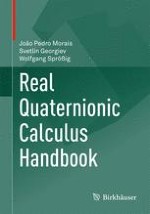2014 | OriginalPaper | Buchkapitel
11. Solutions
verfasst von : João Pedro Morais, Svetlin Georgiev, Wolfgang Sprößig
Erschienen in: Real Quaternionic Calculus Handbook
Verlag: Springer Basel
Aktivieren Sie unsere intelligente Suche, um passende Fachinhalte oder Patente zu finden.
Wählen Sie Textabschnitte aus um mit Künstlicher Intelligenz passenden Patente zu finden. powered by
Markieren Sie Textabschnitte, um KI-gestützt weitere passende Inhalte zu finden. powered by
